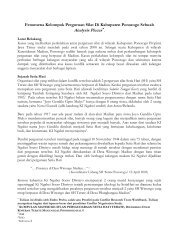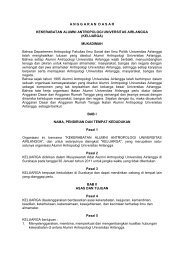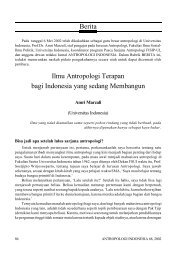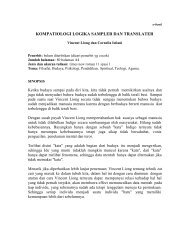The Future of Visual Anthropology: Engaging the Senses
The Future of Visual Anthropology: Engaging the Senses
The Future of Visual Anthropology: Engaging the Senses
You also want an ePaper? Increase the reach of your titles
YUMPU automatically turns print PDFs into web optimized ePapers that Google loves.
widijanto judono e-Library collection - widijanto.wordpress.com<br />
Interdisciplinary agendas 31<br />
<strong>the</strong>ir home over an extended period <strong>of</strong> time, and talking with <strong>the</strong>m about <strong>the</strong>ir<br />
viewing but probably also about many o<strong>the</strong>r things’ (2001: 197–8). I will return to<br />
this in <strong>the</strong> next section.<br />
Cultural studies has an increasing presence in visual methods texts. Emmison<br />
and Smith outline what <strong>the</strong>y see as a cultural studies interdisciplinary ‘tool kit’ <strong>of</strong><br />
concepts for visual interpretation (2000: 66–9), and Rose draws from <strong>the</strong> field <strong>of</strong><br />
‘visual cultures’ (2001: 9–15). Making a similar argument that ‘it is seldom, if ever,<br />
possible to separate <strong>the</strong> cultures <strong>of</strong> everyday life from practices <strong>of</strong> representation,<br />
visual or o<strong>the</strong>rwise’, Lister and Wells (2001: 61) have undertaken to outline a<br />
cultural studies approach to visual analysis – a ‘visual cultural studies’ (2001: 62).<br />
<strong>The</strong>ir essay constitutes a key statement about methods and approaches in visual<br />
cultural studies which is more useful than previous comment from outside cultural<br />
studies, including my own (Pink 2001a). Cultural studies methodology is eclectic<br />
(Lister and Wells 2001: 64; McGuigan 1997) and well known for borrowing from<br />
o<strong>the</strong>r disciplines to use ‘ethnographic, psychoanalytical and critical textual methods’<br />
(Lister and Wells 2001: 63). Its analytical project is coherent. Lister and Wells’<br />
visual cultural studies approach focuses on ‘an image’s social life and history’; ‘<strong>the</strong><br />
cycle <strong>of</strong> production, circulation and consumption through which [images’] meanings<br />
are accumulated and transformed’; <strong>the</strong> material properties <strong>of</strong> images and how<br />
<strong>the</strong>ir materiality is linked to social and historical processes <strong>of</strong> ‘looking’; an understanding<br />
<strong>of</strong> images both as representation through which meanings might be<br />
conveyed and as objects in which humans have a pleasure-seeking interest; and <strong>the</strong><br />
idea that ‘looking’ is embodied – ‘undertaken by someone with an identity’ – and<br />
that visual meanings are thus both personal and framed by <strong>the</strong> wider contexts and<br />
processes outlined above. <strong>The</strong>se <strong>the</strong>mes, succinctly summed up by Lister and Wells<br />
(2001: 62–5), resonate with <strong>the</strong> ideas <strong>of</strong> Rose and Banks outlined above, indicating<br />
that across <strong>the</strong> social sciences and humanities critical approaches to <strong>the</strong> interpretation<br />
<strong>of</strong> images have departed from <strong>the</strong> positivist ‘truth-seeking’ and objectifying<br />
approaches that have been so strongly critiqued and possibly signify a new<br />
approach across disciplines that interpret images.<br />
To sum up, in contrast to Emmison and Smith, who take a largely observational<br />
approach to <strong>the</strong> visual, recent approaches to <strong>the</strong> interpretation <strong>of</strong> visual images in<br />
anthropology, cultural studies and cultural geography have in common emphasised<br />
four key areas. <strong>The</strong>y insist that <strong>the</strong> research pay attention to<br />
1 <strong>the</strong> context in which <strong>the</strong> image was produced;<br />
2 <strong>the</strong> content <strong>of</strong> <strong>the</strong> image;<br />
3 <strong>the</strong> contexts in and subjectivities through which images are viewed; and<br />
4 <strong>the</strong> materiality and agency <strong>of</strong> images.<br />
Perhaps most importantly, <strong>the</strong> arguments developed above have shown that, for<br />
<strong>the</strong> social researcher who is interested in understanding <strong>the</strong> relationship among<br />
people, discourses and objects, it would be important to focus on each <strong>of</strong> <strong>the</strong>se areas<br />
<strong>of</strong> visual interpretation, as <strong>the</strong> visual meanings that she or he seeks to understand










